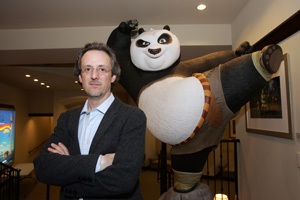When employees start work at DreamWorks Animation SKG Inc., they might feel a little nervous about a first breakfast with the boss.
But it’s not because they’re breaking bread with an immediate superior. Rather, they’ve been called in to chat with a near billionaire, Chief Executive Jeffrey Katzenberg.
In fact, Katzenberg sits down monthly to answer new employees’ questions over breakfast – and it’s just one way the Glendale animation studio welcomes new staff.
“That’s the point of the meetings: for people to see I don’t bite. I don’t want to be a mystery CEO that is neither seen nor heard,” said Katzenberg, who the Business Journal estimated in May had a net worth of $930 million.
If that sounds atypical for a studio chief in the cutthroat entertainment industry, it is. Despite the glamorous reputation of studios, they aren’t known as generous to the average employee, who may never even meet the studio chief.
It’s no secret that DreamWorks is different. The animation studio has been highlighted the past four years by Fortune magazine for its favorable workplace environment and this month was named as the 14th best place to work in the country – the only L.A. company to crack the magazine’s top 100.
At the studio’s leafy Glendale campus, employees get free breakfast and lunch daily, time to play table tennis and access to an on-premises physician. Then there’s Katzenberg’s daily e-mail message to employees, part of his effort to make the studio feel like a tightknit community.
Judging by the desire of employees to work there, the approach is working. As the studio has stepped up its feature film production, it has hired about 1,000 people in the past three years at its Glendale, Redwood City and India offices.
Katzenberg said that job openings can draw thousands of applicants. The company, which employees 2,151 in California, boasts that only a fraction of its employees leave annually.
Pam Green, vice president for membership at the Society for Human Resource Management in Alexandria, Va., said the studio’s creative environment and all-inclusive atmosphere serve to entice potential applicants and keep current employees happy.
“A home away from home makes people want to work there,” she said.
Starting fresh
As a relatively new studio, DreamWorks Animation has been able to differentiate itself from competitors from day one.
DreamWorks SKG launched in 1994 as a joint venture of Steven Spielberg, Katzenberg and David Geffen. The studio scored with early animated hits such as “Antz” in 1998 and “Shrek” in 2000. The animation unit was spun off as a standalone public company in 2004, with Katzenberg serving as chief executive.
Katzenberg said he has always wanted to make the studio a desirable place to work, and has learned valuable techniques from his board members, who have included Starbucks Corp. Chairman and Chief Executive Howard Schultz and former Pepsi Co. Chief Executive Roger Enrico.
“Both of them were incredibly influential in sharing with me a business philosophy about how to value the people who work for you,” he said.
How does that play out? For one, the 15-acre campus is on a side street in Glendale with fountains and outdoor seating, similar to a college. Daily errands can be conducted without leaving: There’s a carwash, medical clinic and other services. The company estimates all the perks add up to a little more than $3,000 per employee annually.
Late in the workday, Katzenberg sends out his e-mail update, talking about his meetings that day, which range from private-equity investors to network heads to recent hires. Still, one of the biggest challenges has been how to retain a homey environment as the company grows.
In 2007, Katzenberg announced that all of the studio’s future releases would be shown in 3-D, which led to a spate of hiring at the company, in part to develop a proprietary filming technology.
To handle the work, he brought in Dan Satterthwaite to lead the human resources department that year.
“My mandate was to make sure that during rapid expansion, that we maintained the sense of a small company,” Satterthwaite said.
And that’s also not easy in an industry that has come to rely on monster box-office hits to drive profits.
DreamWorks Animation’s two features last year, “Kung Fu Panda 2” and “Puss in Boots” grossed more than $1 billion combined at the box office. Each took several years of development and production – meaning that the stakes are high for everyone.
“We have to do a phenomenal job each time. It requires an element of risk-taking,” Satterthwaite said.
It also requires that employees don’t feel like the threat of termination is hanging over their head if they should make an error. Scott Seiffert, a marketing employee, said that even in a high-stakes industry that atmosphere has been established.
“Jeffrey and the whole team have created an absolute haven for an artist: a real place where we can come together as a community and try new ideas” he said. “I feel like I’m part of a family.”

